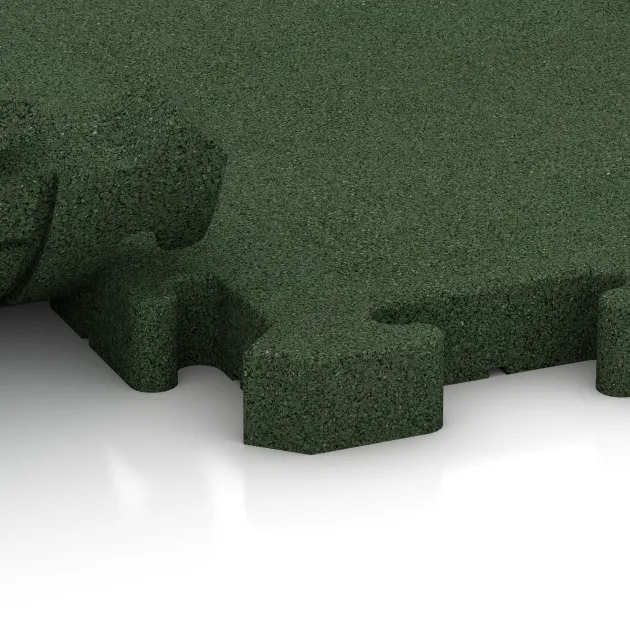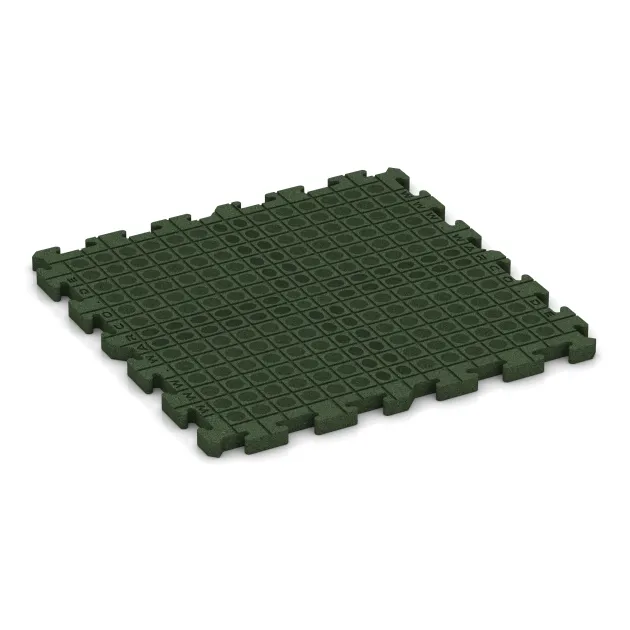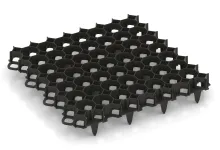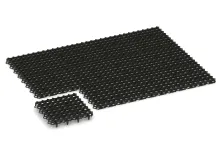Dog floor tile TZ "Grass Green"
- /
-
Delivery in approx.
7-14 days - £48.50 / 1 Piece / m²
- (30.28 kg / Piece)
EAN: 4251469340725 | Item no.: 4072
The WARCO dog floor tile is a hard-wearing, all-purpose surface made from PU-bonded ELT rubber granulate. It provides safe, durable ground wherever dogs live, rest, train or receive care – from private homes and breeding facilities to shelters, vet clinics and indoor sports halls. With its continuous puzzle interlock, each tile locks tightly into the next to create a stable surface that performs just as well in permanent installations as in temporary or mobile layouts.
Material and structure
The tile base is PU-bonded ELT rubber granulate. As an option, the surface can be finished with a coloured EPDM wear layer that is through-dyed, UV-stable and extremely durable. EPDM is free from harmful substances and even meets the strict standards for baby toys – making it completely safe in direct skin or paw contact.
Formats and thicknesses
Dog floor tiles are available in two sizes and three thicknesses:
• 50 × 50 cm: suitable for both indoor and outdoor use.
• 100 × 100 cm: for indoor, weather-protected areas only; ideal for medium to large spaces such as training and sports halls.
• 1.8 cm (BZ): must be laid on a bound base; outdoors up to 40 m²; an excellent choice for halls.
• 3 or 4 cm (TZ): suitable indoors and outdoors; provide reliable insulation and effective cushioning.
Applications and benefits
The dog floor tile creates safe, easy-to-clean surfaces in kennels, runs, rest areas, training zones and agility courses, as well as on mobile competition floors. It is widely used in shelters, clinics and dog-sport facilities. Outdoors, it keeps areas usable in any weather – no dust in dry spells, no mud in the rain, no standing water after downpours.
Properties
Slightly elastic and joint-friendly, the tile is thermally insulating, hygienic and low-maintenance. It is water-permeable, dries quickly after rain and can be hosed down or disinfected with ease. The surface offers secure footing and remains reliably weather- and frost-resistant over time.
Discount
Product Highlights
Characteristics
Product Details – Material and Structure
Comparative values
To calculate how many tiles you need for your project, simply use the online installation planner available in the shop. This free browser-based tool is directly accessible on each product page – just below the price and quantity selection. Click on “Plan installation” to open the tool instantly – no registration or download required.
Enter the dimensions of your area, such as the length and width in metres. The planner will then automatically calculate the total number of tiles required, including a realistic allowance for offcuts. You’ll also be shown a suitable layout pattern for the selected product. The tool is user-friendly, accurate and ideal for planning your material requirements with confidence.
Yes, that is the standard approach. The vast majority of our customers – whether private, municipal, or commercial – install the delivered WARCO tiles themselves or with their own staff. The installation is simple and requires no special skills. Only fitting the curb into a concrete foundation with back support demands a little extra craftsmanship. Cutting the elements to size and laying them on a suitable substrate is not challenging. You can find all essential installation information in our Expert Advice – FAQ section on our website.
WARCO offers several connection systems for floor tiles, each differing in design, installation method and visual appearance. Below is an overview of the key differences:
Puzzle joint (visible)
In this system, the tile edges feature an interlocking profile reminiscent of classic jigsaw teeth or mushroom-shaped connectors. During installation, the profiles of adjacent tiles interlock to form a continuous connection across the full tile thickness.
The joint profile may be formed directly during pressing or precisely cut after the tile has cured. Whether the joint is visible in the finished surface depends on the edge finish (e.g. with or without chamfer) and the surface colouration.
The symmetrical shape ensures uniform load transfer and makes this type of joint the most mechanically stable option.
Plug-in connectors (plastic dowels)
This system uses separate connecting elements, typically round plastic dowels, which are inserted into pre-drilled holes along the sides of the tiles. The tiles themselves have smooth, straight edges similar to precast concrete slabs.
Installation is carried out in a half-bond (stretcher bond) pattern: each tile is connected via dowels to two tiles in the row above and two in the row below. This prevents lateral shifting, although some movement along the length of the dowels remains possible. For this reason, an edge restraint must be installed around the perimeter to stabilise the entire area.
Concealed puzzle joint
This method is based on the same mechanical principle as the classic puzzle joint, but is designed to be invisible in the finished surface. The interlocking profile is located on the underside of the tile, integrated into a rebated step joint.
Two tile edges feature a positive locking profile, the other two a matching negative profile. When laid, the tiles interlock securely from below, forming a durable mechanical connection. From above, the surface appears seamless and aligned, typically with a clean, square joint pattern similar to a chessboard layout.




















































